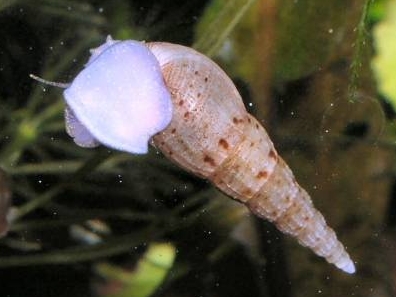Neritidae: Nerite Snails
Note that common names for this group have become complex and sometimes seller-specific relating to the color of the shell.

Neritina sp. photo from Essjay. See the bottom of this post for additional photos of this highly variable group of snails.
Description
Nerites are fairly small snails with very thick, globose shells. The family contains species that range from freshwater to marine environments (note: the marine species should NEVER be acclimated to lower salinities). Nerites seen in the freshwater aquarium trade belong to three genera:
Neritina,
Theodoxus, and
Clithon. The most commonly seen species for sale are:
- Neritina reclivata (olive Nerite)
- Neritina virginea (virgin Nerite)
- Neritina natalensis (zebra Nerite)
- Theodoxus fluviatilis (river Nerite)
- Clithon corona (horned or spiny Nerite)
With few exceptions, the “freshwater” Nerites sold in the aquarium trade are not completely freshwater. Some are brackish but tolerate freshwater, others are found in freshwater to brackish regions and tolerance for freshwater may vary with collection location. Species found in freshwater, again with few exceptions, cannot reproduce in freshwater. There is some evidence of various
Theodoxus species being able to reproduce in full freshwater (there is at least one
Theodoxus species that has been found in totally isolated freshwater environments), but success cases are still relatively uncommon.
Nerites have separate genders and lay small, calcareous, white eggs ~1-2mm in size on hard surfaces. Part of the difficulty involved in breeding many Nerite species is that the offspring generally do not hatch out as small snails, but rather go through a larval stage more common of marine species called a
veliger. This stage is free-swimming, incredibly small, and incredibly difficult to feed. In some species that normally hatch as veligers, egg cases have also been observed to rarely hatch in captivity as a small snail instead, but the reason for the difference is unclear. A downside of Nerites is that, even though most sold in the trade cannot produce surviving offspring in freshwater, if a male and female are present, they will still attempt to be prolific. Some hobbyists find the abundance of little white specs on everything to be an eyesore.
Care
Nerites can be kept in tropical tanks and will eat film algaes and uneaten fish food. They generally will not eat hairy algaes. The water for Nerites should be hard, with a fairly high pH to avoid shell erosion. A pH of around 7.8 and >6dKH is a good target. In more acidic or soft conditions, the shells are very prone to pitting and rapid erosion. Fortunately, Nerites are pretty good at repairing these damaged areas when environmental conditions improve, so patching is rarely a concern for badly-eroded shells.
Nerites that come from a wide range of salinities in the wild may be problematic in a freshwater aquarium.
N. reclivata is perhaps the most problematic in this regard. Hobbyists with Nerites from brackish regions often remark that the snails do not spend much time in the water or regularly escape the tank even when there is a lot of space between the waterline and the rim of the tank. In fact, this is a big warning sign that the snails are unhappy in their environment, and the behavior can be stopped by adjusting the salinity (usually increasing it, since the behavior is generally in response to full freshwater). When the conditions aren't changed, the snails usually don't survive very long and tend to die within a few weeks to months. Nerites that are content in their environmental conditions will live for years and can even be kept in open-topped tanks, provided that there is at least some space between the waterline and the tank rim to make sure the snails don't fall out by accident when looking for food. Occasionally crawling a small distance out of the water for a short period of time is normal behavior, but spending most of the time out of the water or trying to escape the tank on a daily basis is a sign of stress.
Other Photos of Nerites
Examples of
Neritina natalensis, from Essjay. Common names for this species include Zebra Nerite and Red Onion Nerite.
Examples of Neritina sp. from Essjay. These are likely color variations of either
Neritina virginea (Virgin Nerite) or
Neritina reclivata (Olive Nerite).
Clithon sp. from Essjay. Most species of Clithon have spines of varying lengths, although this one does not.
Theodoxus fluviatalis photo by Michael Manas on
wikipedia.
Neritina sp. by Gamegurl564









